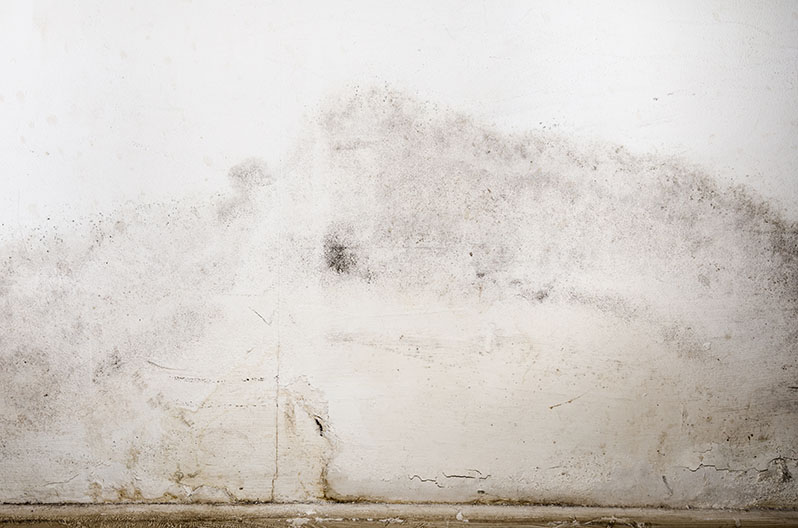Do you have white mold growing on walls, countertops, or even the wooden beams in your attic? White mold is a sign of a water problem and will keep coming back until you make repairs. However, you can clean white mold easily with items you probably already have at home. We cover how to get rid of white mold. Plus, we look at whether white mold is dangerous and how to prevent it from returning.
Get Rid of Your White Mold Problem Fast. Call 888-681-1071 Now for a Fast, Free Quote and Immediate Mold Removal.
How To Clean White Mold
While specialized chemicals are available, you probably already have the best tools for removing white mold at home. Hydrogen peroxide will get rid of white mold on almost anything, while bleach is best for killing white mold on solid surfaces. However, white vinegar and baking soda are also good at removing white mold.
Aside from the cleaner itself, you will also need a spray bottom, a soft-bristled scrub brush, and a few clean rags to get rid of white mold in your home. You may also want to wear thick rubber gloves to protect your hands.
Regardless of which method you choose, remember that mold is the symptom of a moisture problem. Unless you locate and repair the water problem, the mold will return.
1. Hydrogen Peroxide
An effective anti-bacterial and anti-fungal solution, hydrogen peroxide will kill white mold on nearly any surface. Use the spray bottle to saturate the moldy area and allow the hydrogen peroxide to set for at least 10 minutes. Then scrub the area with the brush and wipe clean with the damp rag.
2. Bleach
Bleach is the best white mold remover for walls, countertops, and other solid surfaces. Add one-quarter cup of bleach to a quart of bleach, then spray it onto the white mold. Wait 30 minutes, then wipe the area clean with a damp towel. You can clean stubborn white mold by scrubbing the surface gently. Remember that bleach can stain, so use an old rag or a white towel.
3. White Vinegar
A mild acid, regular white vinegar is slightly less effective at killing white mold than hydrogen peroxide or bleach. Again, cover the moldy area using the spray bottle and allow it to work for an hour. Then wipe the area clean with a damp rag. Repeat the process if necessary to remove all the white mold.
4. Baking Soda
Although it is the least effective of these methods, baking soda is a white mineral powder that can kill white mold. Dissolve a quarter teaspoon of baking soda in a quart of water and apply it to the moldy area with a spray bottle. Use the scrub brush to remove the mold from the surface immediately. Wipe clean with a damp rag and repeat if necessary.
What Is White Mold?
Due to sensationalized concerns about black mold, there is a myth that color determines the type of mold. However, most molds can range in colors like black, white, grey, blue, green, brown, and pink. White mold is nothing more than any of the more than 100,000 species of mold that happens to appear white.
What Does White Mold Look Like?
In the early stages, white mold usually looks like a fine white powder. As it grows, it often looks fuzzy and forms circular shapes. It can eventually become thick and even shaggy-looking, forming thread-like structures or clumps.
Is White Mold Toxic?
Because of misleading reports about so-called toxic black mold, there are unnecessary concerns about the color of mold. All molds pose minor health risks, usually similar to allergy symptoms. However, mold can cause respiratory illnesses or other conditions in rare cases. These are most common in those with weakened immune systems.
What Causes White Mold?
From plumbing and roof leaks to excessive humidity and condensation, any amount of water will eventually cause white mold. It can even appear after floods and sewage backups.
Where Does White Mold Grow?
Although it can appear anywhere, white mold commonly grows on wood, leather, fabrics, and clothing. It often grows on wooden beams in both attics and crawls spaces that have issues with humidity, condensation, or leaks. Wood furniture is also conducive to white mold if it remains damp.
Why Did White Mold Return After I Cleaned It?
All molds are a symptom of a persistent water issue. White mold will return if you clean it without fixing the water problem. The only way to permanently get rid of white mold is to find and resolve the source of water that caused it.
Who To Call for White Mold Removal and Cleanup?
If you cannot get rid of white mold with regular cleaning, you should call a mold removal company to address the issue. Not only will they remove the mold, but they will also find and fix your water problem.
How Do I Tell the Difference Between White Mold and Efflorescence?
At first glance, it’s easy to mistake white mold and efflorescence for one another. Efflorescence is a build-up of minerals and salt on the surface of masonry as water moves through the material. White mold is much less common on masonry, especially if there isn’t any wood nearby.
If you are concerned, you can do a home test to determine whether it’s white mold or efflorescence. Spray the masonry with clean water and then gently wipe the surface clean. Efflorescence will dissolve, leaving the area clear. White mold may streak, but it usually clings to the surface unless you apply significant pressure or scrubbing action.
Get Rid of Your Mold Problem Permanently
Are you tired of constantly cleaning white mold? Then let our local mold removal specialists deal with the problem permanently. Call 888-681-1071 now for a free quote on mold removal services.





